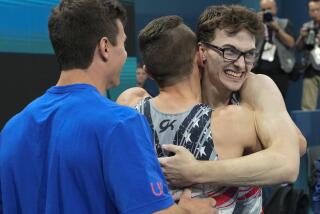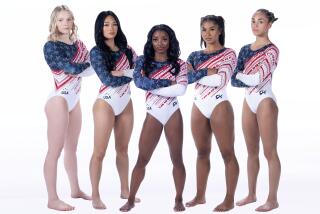Acrobatic Troupe Has Nice Gear but No Place to Use It : Gymnastics: Olympics-caliber equipment sits gathering dust in a storage room at Compton College.
Trainer Roosevelt Porter often visits a musty-smelling place at Compton College known as the dead-weight room, a dark, almost forgotten storage cubicle below a dance floor and behind bleachers in the school’s aging gymnasium.
Two side horses, three sets of rings and a pair of parallel bars piled behind racks of rusting weights have been collecting dust there for seven years. Also stored there are tumbling mats, two balance beams, three springboards and a vaulting buck.
Porter hopes to use the apparatus--a gift from the U.S. Olympic Committee--to expand the Ebony Flyers, an acrobatic and tumbling troupe he founded to give kids an alternative to gangs and drugs. But today the college appears no closer to finding a place for the equipment than it did shortly after the 1984 Olympics concluded, when Porter was surprised to find delivery men unloading the apparatus at the gymnasium door.
“We are competing against the street,” said Tony Mont, 28, the oldest tumbler in the group and an assistant to Porter. “We get a lot of good talent here, but we can’t practice, or sometimes we don’t have enough room just for tumbling. So many of these kids we could keep (with a gymnastics program), but they go back to the street.”
Porter, a former Fremont High School gymnastics star, founded the Ebony Flyers 13 years ago as the all-girl Ebony Jewels gymnastics team. He formed the Jewels with 12 recruits from a group of about 60 children who attended Compton College’s Kollege for Kids, a Saturday program in which Porter teaches. Kollege for Kids offers classes ranging from baby tumbling to remedial high school mathematics.
The Jewels eventually grew to include boys, but because the team lacked enough gymnastic apparatus, it evolved into a troupe that performs tumbling routines choreographed by Porter.
About 20 children currently train with Porter, hoping to earn one of the 12 performing roles on the Ebony Flyers. Porter says it takes as long as two years for a child to master the routines.
Several youths who did perform in the entourage have obtained jobs in the entertainment industry. Mont, for example, was hired to tumble and dance in Japan.
The Flyers have received enthusiastic responses to their performances at halftimes of Laker games. Next month the troupe will twist and tumble through a performance at the Los Angeles County Fair.
It was because of the Flyers’ 1984 performance at the Coliseum’s outdoor festival during the Olympics that the Olympic Committee became aware of the group and donated the gymnastic equipment to the college.
“They were looking to get the equipment moved out quickly,” Porter explained. “It was just sitting in a big warehouse in L.A. somewhere.”
The success of the Flyers has benefited Kollege for Kids as well. Enrollment, which costs $45 for a 16-week session, has tripled in the past three years, said Velta Jones, an associate dean of instruction in charge of community services at Compton College.
“You’d be surprised how (the Flyers) draw kids and parents to the Kollege for Kids,” she said.
Yet practice time for the Flyers is restricted to two hours two nights a week in the Tartar gymnasium. Setting up the gymnastic equipment, particularly during basketball season, is next to impossible, Porter said.
“It takes up most of practice time to set it up,” he said. “The college gym is not large enough with all its activities to give us more time. Besides, we need room. We have a 40-by-40 (foot) spring floor alone.”
When, on rare occasions, Porter does break out some of the equipment, it comes as a surprise to his youngsters.
Jones said the college has only begun “the talking stages” in its search for facilities for the Flyers. It would like to see a local merchant donate space because none seems likely to be found at the college.
Porter specialized in rings and floor exercise between 1959 and 1962 at Fremont, where he was captain of the gymnastics team. After a stint in the Army and several years of working at odd jobs, he returned to school at Compton in 1975 intent on getting a degree in art.
“My intention was in no way to become a trainer,” he said. But he discovered that he could get an increase in Army funds for college if he took an internship in the athletic training room. That led to his certification as an athletic trainer four years later and eventually to his hiring in 1985 as the school’s trainer.
In the training room, not far from where the gymnastic apparatus is stored, Flyer memorabilia abounds. Trophies, ribbons and certificates line the walls near a weathered desk and a hot tub.
Porter points proudly to a scrapbook that contains awards from the past three International Performing Arts Competitions. There is also a worn, yellowed photograph, clipped from his high school yearbook, of a handsome, muscular Porter with his equally well-built Fremont teammates.
Things were different then, he said. “Today there are street corners across from this school where you can’t walk freely, where your life is in danger if you turn the wrong corner, just because of who you are,” he said.
Parents and performers say the Ebony Flyers give them an alternative to street life. Said Deborah Fords, whose 10-year-old daughter, Sharonda Maxwell, has been tumbling for six years: “As long as they are here practicing, that’s less time they have to be out on the streets around hoodlums.”
Jessie Fitzgerald, 13, a three-year veteran of the Flyers, was more blunt: “If I wasn’t here, I know I would probably be out there getting in trouble.”
But Nyiki Swain, 14, who has been a Flyer since she was 3 years old, said it is hard to hold the interest of everyone, particularly without more equipment.
“Some of these (gang-type) guys come in here and look around and kind of like it, so they stay for two or three months,” Swain said. “Then they leave.”
Explained Porter: “Kids are so influenced by their peers that they may like it . . . but the pressure on the street, from friends who see this as a negative thing, is such that those kids eventually leave.
“It’s a battle (to save these kids). It’s like David and Goliath. You have the slingshot, and the streets are Goliath.”
Porter holds out hope that his dream of using the stored gymnastic equipment will materialize. But he is reticent. There is only so much he can do to help kids right now, he said.
Mont, who learned how to tumble on old mattresses in alleys, thinks things are not happening fast enough. “All we want is a building,” he said.
For now, however, Mont is resigned to tumbling in the gymnasium on portable mats. When practices are over, he helps carry them back to the dead-weight room.
More to Read
Go beyond the scoreboard
Get the latest on L.A.'s teams in the daily Sports Report newsletter.
You may occasionally receive promotional content from the Los Angeles Times.






